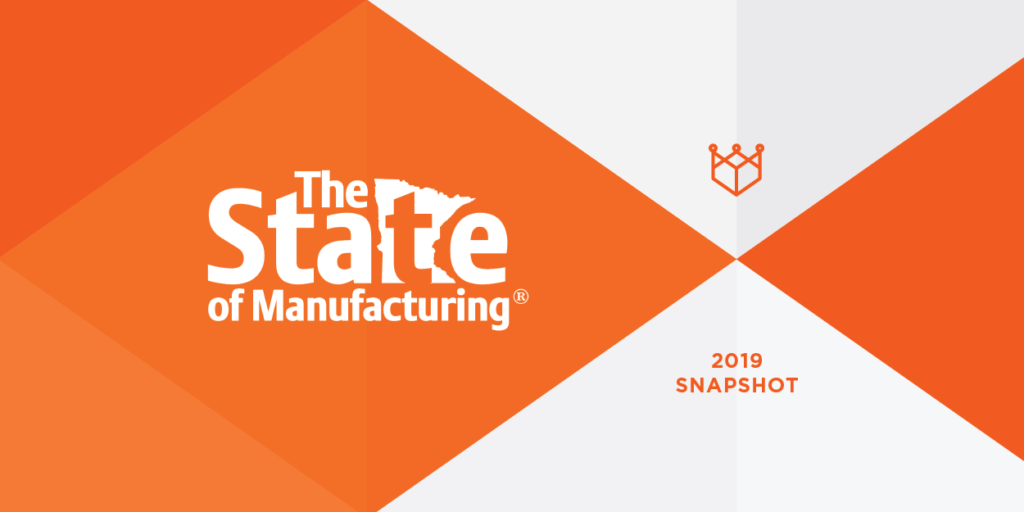
Manufacturing is one of Minnesota’s biggest industries, employing over 300,000 people. It drives the shipping and fulfillment industry that also thrives here. That’s why the state of the manufacturing industry is of great importance to third-party logistics providers. Each year, Enterprise Minnesota does a fantastic job of capturing the state of the industry with their “State of Manufacturing®” survey.
![]()
“… Minnesota manufacturers are thriving and feeling confident about the futures of their companies. But the biggest factor casting a shadow on that enthusiasm is the ongoing worker shortage, which has no end in sight.” – Bob Kill, Enterprise Minnesota president and CEO
![]()
About the survey, and how it serves us
The State of Manufacturing® is an annual survey of over 400 manufacturing executives, including CEOs, CFOs, COOs, presidents, vice presidents and managing officers (oh my!), of Minnesota-based manufacturing companies, as well as over 100 other manufacturing companies outside the Twin Cities area.
The survey serves as one of the ideal gauges for the logistics industry, which is directly impacted by the output of Minnesota’s many manufacturing businesses. When these businesses do well, so do shippers, warehousing providers, and every other link in the supply chain.
But you came here for the numbers, so let’s get to some of the survey’s highlights.
Things are really looking up, like optimism and growth
Every year, the survey kicks off with a key question: how confident do you feel right now about the future of your company? For 2019, as the economy continues to boom, 93% of manufacturing executives reported feeling optimistic about upcoming forecasts.
“Despite economic uncertainty, Minnesota manufacturers are thriving and feeling confident about the futures of their companies,” said Bob Kill, Enterprise Minnesota president and CEO.
As optimism remains high, half of all manufacturers also stated that 2019 would be a year of expansion for their company, which bodes well for shipping companies, carriers and other supply chain entities. Only 5% of executives expect a recession for their company, and 39% expected to at the very least remain flat. 59% of companies are also expecting increases in gross revenue, 45% are expecting increases in profits, and 31% expect increases in capital expenditures. All these estimated increases should really get supply chain professionals excited. Simply put, when manufacturing output is high, there are more products to move about the country.
What’s on MN manufacturers’ minds?
The second major portion of the survey ranks the leading concerns of manufacturers, most of which deal with costs, regulations and workforce issues. Here are the top 8 ranked issues (by the percentage of executives concerned by them):
- Cost of health care coverage: 58%
- Finding qualified workers: 46%
- Government policies and regulations: 40%
- Retaining qualified employees: 37%
- Costs of employee salary and benefits: 29%
- Developing future leaders: 23%
- Foreign competition: 13%
- Getting products to market: 10%
It’s not at all surprising to see costs and regulations as top concerns, but it’s the skills gap that’s making waves in the industry for 2019. While there are a lot of people on the market for jobs, businesses are still struggling to find and retain qualified people to fill their positions. According to the survey, 71% of all companies indicated that attracting qualified workers is their largest growth impediment. This issue seems to escalate for manufacturers with over 50 employees; 74% of them reported that finding and retaining qualified workers is their greatest challenge.
If manufacturers are unable to fill their roles with qualified employees, third-party outsourcing for services like shipping, warehousing and fulfillment could be a viable choice. The survey showed that 21% of companies are navigating the worker shortage through outsourcing, so it’s clear that many manufacturers are pursuing partnerships that can benefit their internal processes and overall supply chain.
So now what?
While confidence and product output are high, it seems that manufacturers are laboring to keep up with their own growth. This presents a great opportunity for these manufacturers to partner with third-party logistics providers who can help their businesses grow, including how they manage their warehousing space and optimize their workforce. The timing just couldn’t be better.
Want to build supply chain solutions for your manufacturing business? Let’s chat. Contact me or connect with me on LinkedIn today.
Related articles:
Lead by reducing manufacturing and shipping lead times
Threading the needle for a global fabrics manufacturer
The bendy, flexible shipping solutions that saved this materials manufacturer
King delivers shocking results to a multi-billion-dollar manufacturer







 Joel Rice
Joel Rice